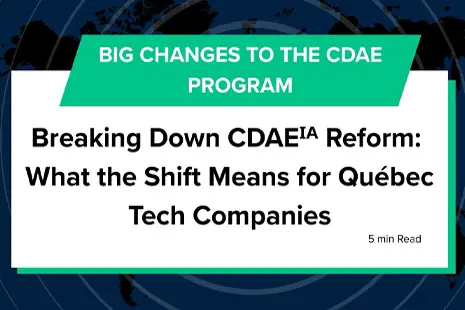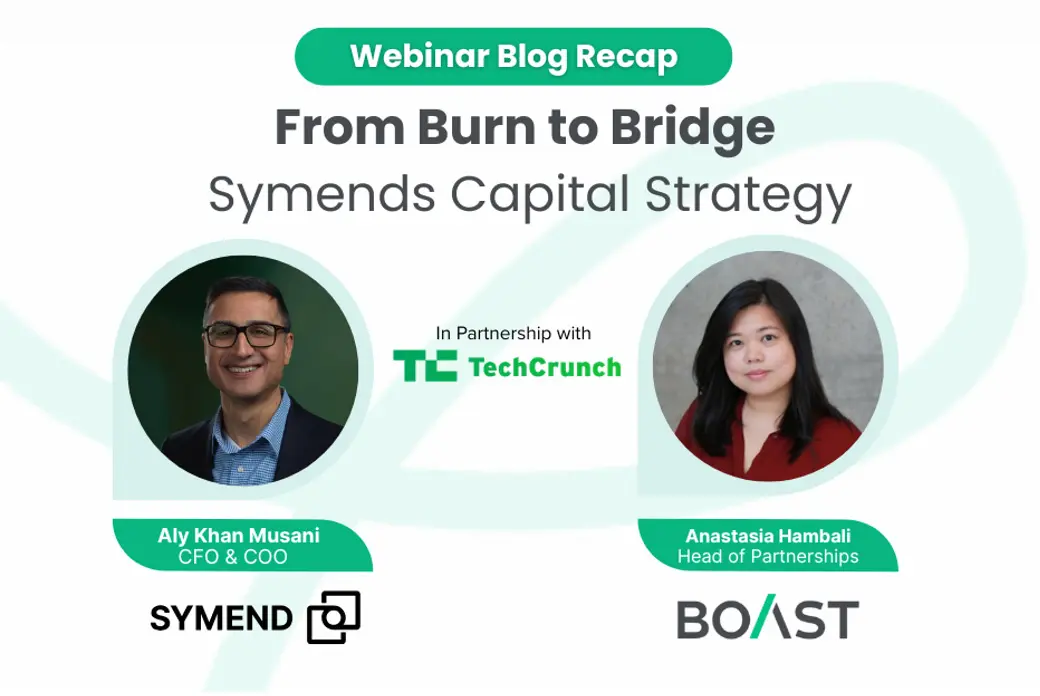For founders navigating the current startup landscape, cash is king: Every dollar needs to be spent thoughtfully, and with a clear understanding of the investment’s potential risk and return.
But as any founder will tell you, it’s a tricky balance to ensure that you’re doubling down on innovation and hiring during critical periods of growth—all while keeping enough financial cushion for any uncertainty ahead. After all, there’s no singular approach to funding R&D efforts, which can be a blessing and a curse given the many avenues for accessing equity in the current startup landscape.
To help teams map out their approaches to funding R&D projects, Boast’s Director of Partnerships Anastasia Hambali recently spoke with our VP of Product John Can Karayel for the webinar Building your R&D Capital Strategy. During this chat, Anastasia and John unpack proven strategies and valuable insights for startups who are looking to accelerate in 2023, which we’ll outline here.
Before diving into those takeaways, however, it makes sense to first define what we mean when discussing R&D in the context of startups.
How do startups define R&D?
In perhaps the most bare bones sense, R&D can be described as a company’s product roadmap divided into chunks. Pieces of the larger product development strategy are separated into smaller, actionable projects, with associated milestones in place to help teams track progress. For most early-stage startups, ensuring that there is enough capital to see R&D projects (and ultimately the larger product roadmap) through to completion is essential. While we’ll discuss the additional long-tail benefits of doubling-down on R&D investment later on, the baseline justification boils down to ensuring the business ultimately has a product and a path to revenue.
What kinds of capital are available to founders today?
Fortunately, right now may be one of the best times for founders to seek out this critical capital, as there are a bevy of alternative funding solutions available. These include:
- Government grants and tax credits: In both Canada and the US, qualifying businesses that engage in innovative R&D can take advantage of several different tax credit and grant offerings. In Canada, these include the Industrial Research Assistance Program (IRAP) from the National Research Council (NRC), which is available to profit-oriented SMBs with 500 or fewer full-time equivalent employees, as well as industry-specific programs like the Interactive Digital Media Tax Credit (IDMTC) offered in British Columbia and Ontario. There’s also of course the banner SR&ED tax credit, which enables qualifying businesses to get up to 64 percent of their engineering spend as cash back, even if the startup isn’t yet profitable. In the US, businesses can access grants and tax credits through the Small Business Innovation Research (SBIR) program. US companies can check what is currently available on our partner’s page.
- Crowdfunding platforms: Beyond tax credits and grants, founders can also take part in crowdfunding campaigns via platforms like Kickstarter, IndieGogo. WeFunder is another such portal that is more commonly leveraged for accumulating direct equity (as opposed to backup capital). These campaigns call on founders to really advocate for their startups and to have a product roadmap and business plan in place to woo funding—though, arguably, funders may be less discerning than traditional lenders or equity investors, depending on the nature of the crowdfunding platform. It’s important to note that local regulations on a state- or province-level may hinder the ability of startups to leverage these funding solutions.
- Corporate sponsorships or partnerships: Corporate partnerships are another avenue to access resources, expertise, funding or even acquire talent for specific projects. These relationships can become incredibly complicated, however—especially when creating a contract to actually cement the details of the relationship. In these scenarios, it’s not always just a client-customer relationship; it’s often an equity play or even a pay-to-build scenario. Ensuring these details are crystal clear in the corporate or private contract—specifically as it pertains to product ownership once R&D projects are completed—is a critical step.
- Equity or debt: When it comes to debt financing, early stage companies can do this via loans from banks or even alternative investment platforms for R&D. However, this can get tricky at an early stage, as most debt providers prefer to fund GTM activities vs. R&D projects (though this is hardly a rule and many lenders are willing to back R&D). Ultimately it depends on the founders ability to communicate the ROI and importance of the R&D to their funders.
In all of these scenarios, it really comes down to founders being able to paint a clear picture of how their R&D projects will ultimately lead to commercialization. While the burden of proof varies for each of these avenues, in almost every scenario, the more detail that founders can provide around their product innovation, roadmap and path to commercialization—and really the risk and return of the overall project—the better.
Nailing down this narrative is key, and while different investors, lenders, government institutions and other bodies involved in a startup’s R&D capital strategy may all have different priorities, the central founder narrative needs to be consistent and tight.
5 Questions all founders must answer
To take it a layer deeper, here are a few questions every founder should ask when building their R&D Capital Strategy to nail down their narrative.
-
- What is the market potential of the product or service that is being developed?
-
- Investors want to see a large growing market for this because it increases the chances that R&D investment will result in significant revenue. This is the piece that’s directly tied into the DNA of the company.
-
- What is the market potential of the product or service that is being developed?
-
- Does the R&D project provide any competitive advantage?
-
- Again, investors—even grant issuers and the SR&ED program—are all looking for unique or proprietary advantage over competitors. The CRA is on the lookout for authentic innovation as well, making it essential that founders can draw a fine line on this point.
-
- Does the R&D project provide any competitive advantage?
-
- Has the team launched similar products or services before?
-
- If not, are they getting support from the right folks in their network?
-
- This goes into the strength of the management team and founder; if they have been able to successfully launch in the past, great! But if you’re a first-time founder, that’s not necessarily a deal breaker either, so long as you’re tapping into the right resources and guides to help define your product-market fit.
-
- Has the team launched similar products or services before?
-
- How are the R&D project and its outcomes reflected in the financial forecast?
-
- This one is a favorite for John, because it’s one of the most challenging questions for founders to answer. Startups must be able to explain how they can bridge the gap between where they are now and they’re goals over the next 3-5 years to convince debt providers to give funding.
-
- How are the R&D project and its outcomes reflected in the financial forecast?
-
- What are the downside analysis or opportunity costs?
-
- Everyone wants to see that the company has thought out the risks associated with the R&D investment. It means you chose option A over B and C for a good reason. This addresses the build vs. buy discussion, while also establishing an exit strategy.
-
- While this last point applies mostly to later stage companies, having these scenarios mapped from the get-go goes a long way to demonstrating the strength of a founder’s narrative.
-
- What are the downside analysis or opportunity costs?
Extending your runway with R&D/SR&ED tax credits
While actually applying for alternative funding to build an R&D capital strategy is a significant ‘step 1’ in building a capital strategy, businesses need to continually build on these roadmaps to actually extend their runway once their R&D is up and running.
One critical way that businesses like Boast are able to help early-stage startups do this is by working closely with founders to apply for tax credits like SR&ED and leverage them to extend the startups working capital throughout the year.
Because of the cash flow and liquidity crunch in the current market, more customers are taking advantage of programs like Boast’s QuickFund. This solution enables startups to estimate the value of their SR&ED refund throughout the fiscal year, and gain access to up to 64 percent of their R&D spend from the Canadian government as cash refund when they need it most (versus just once annually).
By opening up access to tax-credit equity throughout the year, businesses can proactively re-invest their refund into R&D projects early on, stacking this strategy alongside the other funding methods to ultimately extend the business’s runway.
Where should founders spend SR&ED financing?
While founders can ultimately plug their SR&ED refund into any area of the business that needs a capital boost, early-stage companies reap the most value when they put their SR&ED funding back into their R&D.
That isn’t the only avenue, however, as sales and marketing are also areas of the business that need healthy investment for a startup to scale and grow into new regions and markets. These resources can also be used for talent acquisition, ie. if there is an unfilled VP role within the company.
The most important thing for early stage founders is that their capital strategy affords them optionality and flexibility. With Boast, teams can better craft their R&D strategy, design a powerful narrative for investors, and start accessing SR&ED funding early to ensure they maintain access to critical equity.
To learn how to calculate your potential SR&ED tax credits, download our free step-by-step guide or contact us for a complimentary no-obligation assessment. We’ll go through your projects in more detail, tell you what qualifies and what doesn’t, and provide an estimate of your potential return.


